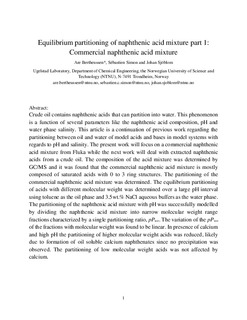| dc.contributor.author | Bertheussen, Are | |
| dc.contributor.author | Simon, Sebastien Charles | |
| dc.contributor.author | Sjøblom, Johan | |
| dc.date.accessioned | 2018-08-28T13:03:25Z | |
| dc.date.available | 2018-08-28T13:03:25Z | |
| dc.date.created | 2018-08-12T11:13:23Z | |
| dc.date.issued | 2018 | |
| dc.identifier.citation | Energy & Fuels. 2018, 32 (7), 7519-7538. | nb_NO |
| dc.identifier.issn | 0887-0624 | |
| dc.identifier.uri | http://hdl.handle.net/11250/2559677 | |
| dc.description.abstract | Crude oil contains naphthenic acids that can partition into water. This phenomenon is a function of several parameters, such as the naphthenic acid composition, pH, and water phase salinity. This article is a continuation of previous work regarding the partitioning between oil and water of model acids and bases in model systems, with regard to pH and salinity. The present work will focus on a commercial naphthenic acid mixture from Fluka, while the next work will deal with extracted naphthenic acids from a crude oil. The composition of the acid mixture was determined by GC/MS and it was found that the commercial naphthenic acid mixture is mostly composed of saturated acids with 0−3 ring structures. The partitioning of the commercial naphthenic acid mixture was determined. The equilibrium partitioning of acids with different molecular weight was determined over a large pH interval, using toluene as the oil phase and 3.5 wt % NaCl aqueous buffers as the water phase. The partitioning of the naphthenic acid mixture with pH was successfully modeled by dividing the naphthenic acid mixture into narrow molecular weight range fractions characterized by a single partitioning ratio (pPwo). The variation of the pPwo of the fractions with molecular weight was found to be linear. In the presence of calcium and high pH, the partitioning of higher-molecular-weight acids was reduced, likely because of the formation of oil-soluble calcium naphthenates, since no precipitation was observed. The partitioning of low-molecular-weight acids was not affected by calcium. | nb_NO |
| dc.language.iso | eng | nb_NO |
| dc.publisher | American Chemical Society | nb_NO |
| dc.relation.uri | https://pubs.acs.org/doi/10.1021/acs.energyfuels.8b01494 | |
| dc.title | Equilibrium Partitioning of Naphthenic Acid Mixture, Part 1: Commercial Naphthenic Acid Mixture | nb_NO |
| dc.type | Journal article | nb_NO |
| dc.type | Peer reviewed | nb_NO |
| dc.description.version | acceptedVersion | nb_NO |
| dc.source.pagenumber | 7519-7538 | nb_NO |
| dc.source.volume | 32 | nb_NO |
| dc.source.journal | Energy & Fuels | nb_NO |
| dc.source.issue | 7 | nb_NO |
| dc.identifier.doi | 10.1021/acs.energyfuels.8b01494 | |
| dc.identifier.cristin | 1601274 | |
| dc.relation.project | Norges forskningsråd: 237893 | nb_NO |
| dc.description.localcode | Locked until 12.6.2019 due to copyright restrictions. This document is the Accepted Manuscript version of a Published Work that appeared in final form in [Energy & Fuels], copyright © American Chemical Society after peer review and technical editing by the publisher. To access the final edited and published work see https://pubs.acs.org/doi/10.1021/acs.energyfuels.8b01494 | nb_NO |
| cristin.unitcode | 194,66,30,0 | |
| cristin.unitname | Institutt for kjemisk prosessteknologi | |
| cristin.ispublished | true | |
| cristin.fulltext | original | |
| cristin.fulltext | preprint | |
| cristin.fulltext | postprint | |
| cristin.qualitycode | 2 | |
